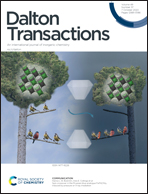Three-component D–A hybrid heterostructures with enhanced photochromic, photomodulated luminescence and selective anion-sensing properties†
Abstract
As an emerging class of hybrid complexes, donor–acceptor (D–A) hybrid heterostructures with advantages of both photoactive organic and inorganic components have provided an excellent platform for the fabrication of multifunctional photoactive materials. In this context, we have demonstrated three novel host–guest D–A hybrid heterostructures, {[Ln(BCEbpy)(H2O)4][CoIII(CN)6]·4H2O}n (1 (Eu), 2 (Dy), 3 (Sm)), based on the anionic Co(CN)63− and cationic coordination layers assembled from a viologen functionalized tecton and Ln(NO)3. Due to the introduction of an electron donor, CoIII(CN)63−, the unique hybrid exhibits a highly sensitive and reversible photochromic transformation from light-yellow to brown upon UV-Vis irradiation. More interestingly, accompanied with this photochromic process, hybrid 1 simultaneously possesses a photomodulated fluorescence behaviour. In addition, hybrid 1 shows high sensitivity and selectivity towards Cr2O72− anions with a fairly small LOD of ca. 9.6 × 10−6 M.



 Please wait while we load your content...
Please wait while we load your content...